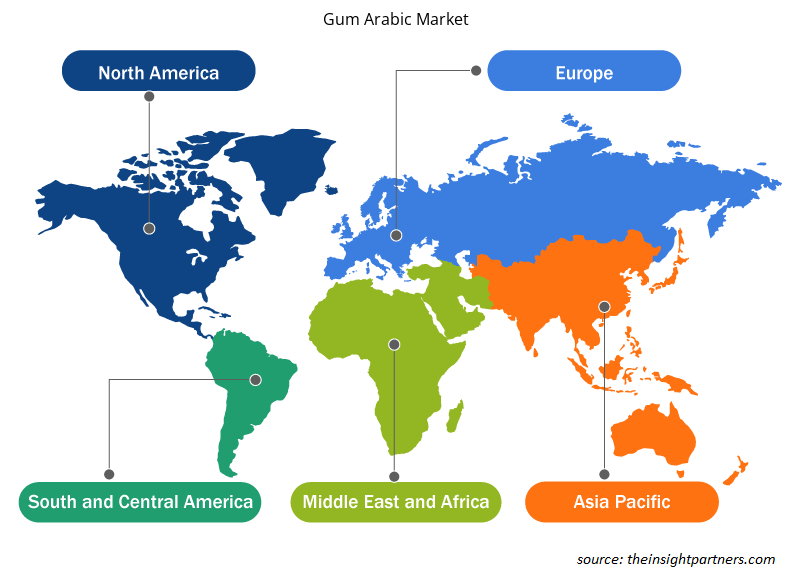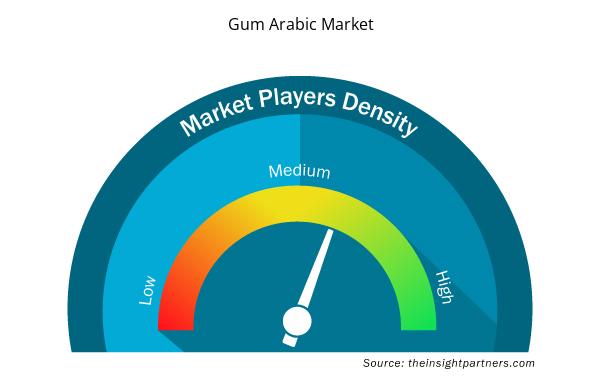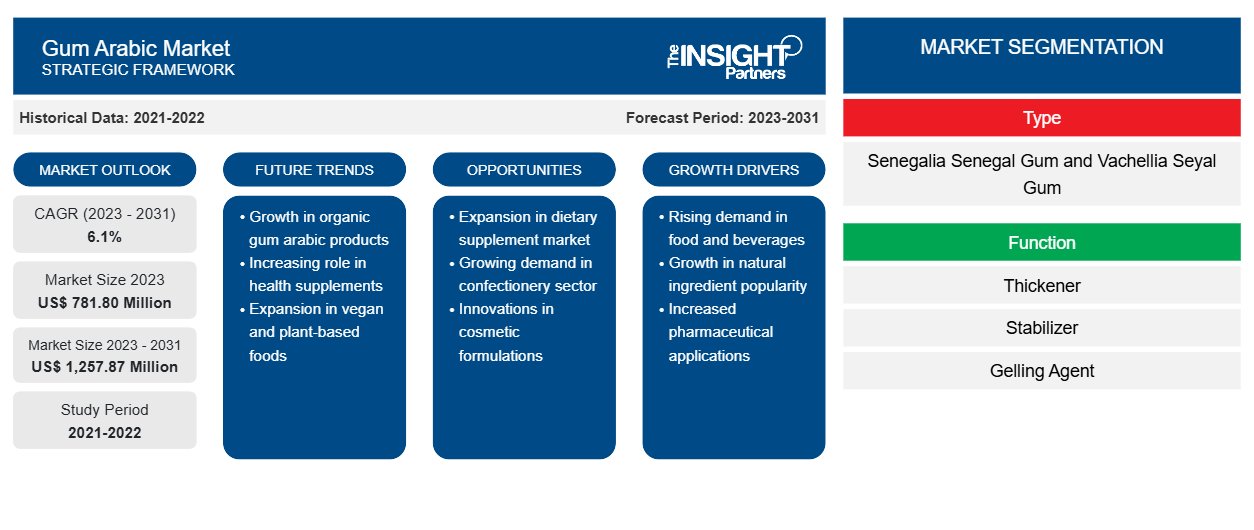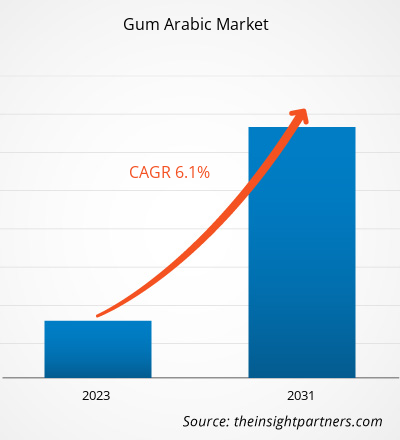阿拉伯胶市场规模预计将从 2023 年的 7.818 亿美元增至 2031 年的 12.5787 亿美元。预计 2023-2031 年市场复合年增长率为 6.1%。人们对有机口香糖健康益处的认识不断提高,这很可能仍是阿拉伯胶市场的主要趋势。
阿拉伯胶市场分析
阿拉伯胶用于食品和饮料、药品和个人护理行业。阿拉伯胶在口香糖生产中用作增稠剂,在水彩颜料中用作粘合剂,在陶瓷釉料中用作添加剂,在香烟中用作卷烟纸。此外,由于其用途广泛,阿拉伯胶是全球最受欢迎的天然乳化剂。由于全球食品和饮料行业对天然产品的需求,阿拉伯胶将在未来一年实现巨大增长。由于天然食品具有健康益处,消费者已转向食用天然食品。阿拉伯胶用作糖霜、软糖、馅料、口香糖和其他糖果中的乳化剂、稳定剂和增稠剂,以及用于粘合软饮料中的甜味剂和调味剂。此外,阿拉伯胶还用于传统的平版印刷和印刷。阿拉伯胶还为油墨提供了出色的附着力,有助于印刷品的持久性。因此,阿拉伯胶应用的多样性是推动全球市场增长的强大因素。
阿拉伯胶市场概况
阿拉伯胶,又称阿拉伯胶、苏丹胶、阿拉伯树胶、阿拉伯胶、阿拉伯树胶、印度胶、塞内加尔胶等,是一种天然胶,产自阿拉伯树胶树汁,分布于非洲干旱地带,如苏丹、尼日利亚和乍得。阿拉伯胶在食品和饮料行业的多种应用领域中得到广泛使用。它可作为粘合剂,将食品成分粘合在一起,并显著保留其物理特性。阿拉伯胶在制药和食品饮料行业的应用日益广泛,为阿拉伯胶市场的主要参与者提供了有利可图的机会。
定制此报告以满足您的需求
您可以免费定制任何报告,包括本报告的部分内容、国家级分析、Excel 数据包,以及为初创企业和大学提供优惠和折扣
- 获取此报告的关键市场趋势。这个免费样品将包括数据分析,从市场趋势到估计和预测。
阿拉伯胶市场驱动因素和机遇
人们对阿拉伯胶多功能性的认识不断提高
阿拉伯胶被认为是天然的、可食用的,并且通常对人类安全。它已被用于治疗各种疾病,改善患者的消化系统和食欲。阿拉伯胶被归类为不可消化的膳食纤维。它还具有一些药用价值,例如减少牙菌斑和促进伤口愈合,这促进了阿拉伯胶在制药领域的应用,从而推动了全球阿拉伯胶市场的增长。此外,阿拉伯胶(塞内加尔阿拉伯胶)是一种复杂的多糖,人类和动物都无法消化。阿拉伯胶是最常用的发泡剂之一,不仅用作发泡剂,还用作各种产品的乳化剂、干燥剂和稳定剂。它是一种天然植物基水胶体或植物或树木渗出物,由多糖和阿拉伯半乳聚糖蛋白 (AGP) 级分组成。因此,食品和饮料行业对天然产品和相关药用功效的日益增长的兴趣可能会在预测期内促进市场的增长。
阿拉伯胶产品需求不断增长
阿拉伯胶产品是从粘性茎和塞内加尔阿拉伯胶树枝的干燥分泌物中获得的。由于对天然成分的需求不断增长,各制造商都专注于采购天然食品成分和原材料。阿拉伯胶在牙科领域的应用范围不断扩大,预计将为阿拉伯胶市场提供潜在机会。它也是一种复合多糖,pH 值为中性,由镁、钙和钾混合而成,可促进牙齿再矿化。此外,它还具有一定的抗菌活性,这进一步推动了整个牙科行业对它的需求。因此,牙科对阿拉伯胶的需求不断增长,预计将在预测期内促进市场增长。
阿拉伯胶市场报告细分分析
有助于得出阿拉伯胶市场分析的关键部分是类型、功能和应用。
- 根据类型,阿拉伯胶市场分为塞内加尔胶和瓦切利亚胶。塞内加尔胶部分在 2023 年占据了较大的市场份额。
- 根据功能,市场分为增稠剂、稳定剂、胶凝剂等。增稠剂部分在 2023 年占据了最大的市场份额。
- 从应用方面来看,市场分为烘焙和糖果、饮料、乳制品和冷冻产品等。烘焙和糖果领域将在 2023 年引领市场。
阿拉伯胶市场份额地域分析
阿拉伯胶市场报告的地理范围主要分为五个地区:北美、亚太、欧洲、中东和非洲、南美/南美和中美。
欧洲地区包括多个发达和发展中经济体,例如德国、法国、意大利、英国和俄罗斯等。食品和饮料行业生活方式的转变对欧洲阿拉伯胶市场产生了显著影响。随着消费者健康意识的增强,预计该地区对阿拉伯胶产品的需求将在预测期内增长。阿拉伯胶在该地区越来越受欢迎,尤其是在德国、法国和英国。预计亚太地区未来几年将以最高的复合年增长率增长。
阿拉伯胶市场区域洞察
Insight Partners 的分析师已详尽解释了预测期内影响阿拉伯胶市场的区域趋势和因素。本节还讨论了北美、欧洲、亚太地区、中东和非洲以及南美和中美洲的阿拉伯胶市场细分和地理位置。

- 获取阿拉伯胶市场的区域特定数据
阿拉伯胶市场报告范围
| 报告属性 | 细节 |
|---|---|
| 2023 年的市场规模 | 7.818亿美元 |
| 2031 年市场规模 | 12.5787亿美元 |
| 全球复合年增长率(2023 - 2031) | 6.1% |
| 史料 | 2021-2022 |
| 预测期 | 2023-2031 |
| 涵盖的领域 | 按类型
|
| 覆盖地区和国家 | 北美
|
| 市场领导者和主要公司简介 |
|
阿拉伯胶市场参与者密度:了解其对业务动态的影响
阿拉伯胶市场正在快速增长,这得益于终端用户需求的不断增长,而这些需求又源于消费者偏好的不断变化、技术进步以及对产品优势的认识不断提高等因素。随着需求的增加,企业正在扩大其产品范围,进行创新以满足消费者的需求,并利用新兴趋势,从而进一步推动市场增长。
市场参与者密度是指在特定市场或行业内运营的企业或公司的分布情况。它表明在给定市场空间中,相对于其规模或总市场价值,有多少竞争对手(市场参与者)存在。
在阿拉伯胶市场运营的主要公司有:
- AEP 胶体
- 农业国际有限公司
- 阿兰德和罗伯特
- 远佳品牌
- 霍金斯瓦茨有限公司
- ISC 牙龈
免责声明:上面列出的公司没有按照任何特定顺序排列。

- 获取阿拉伯胶市场顶级关键参与者概述
阿拉伯胶市场新闻及最新发展
通过收集一手和二手研究后的定性和定量数据来评估阿拉伯胶市场,其中包括重要的公司出版物、协会数据和数据库。以下是市场发展情况的列表:
- 全球营养和农业起源与加工领域的领导者 ADM 和专注于加速亚洲可持续食品商业化的亚洲可持续食品平台今天宣布其合资公司 ScaleUp Bio 正式成立。这是新加坡第一家为食品应用提供精准发酵合同开发和制造组织服务的公司。(来源:ADM,公司新闻,2022 年)
- 全球领先的口味和营养公司凯里 (Kerry) 今天正式开设了非洲大陆最大、最先进的口味制造工厂。(来源:凯里集团有限公司,简报,2022 年)
阿拉伯胶市场报告覆盖范围和交付成果
“阿拉伯胶市场规模和预测(2021-2031 年)”报告对以下领域进行了详细的市场分析:
- 范围内涵盖的所有主要细分市场的全球、区域和国家层面的市场规模和预测
- 市场动态,如驱动因素、限制因素和关键机遇
- 未来的主要趋势
- 详细的波特五力分析和 SWOT 分析
- 全球和区域市场分析涵盖关键市场趋势、主要参与者、法规和最新市场发展
- 行业格局和竞争分析,涵盖市场集中度、热点图分析、知名参与者和最新发展
- 详细的公司简介
- 历史分析(2 年)、基准年、预测(7 年)及复合年增长率
- PEST 和 SWOT 分析
- 市场规模价值/数量 - 全球、区域、国家
- 行业和竞争格局
- Excel 数据集


- Fill Finish Manufacturing Market
- Electronic Toll Collection System Market
- Excimer & Femtosecond Ophthalmic Lasers Market
- Airline Ancillary Services Market
- Gas Engine Market
- Rare Neurological Disease Treatment Market
- Volumetric Video Market
- Third Party Logistics Market
- Workwear Market
- Embolization Devices Market

Report Coverage
Revenue forecast, Company Analysis, Industry landscape, Growth factors, and Trends

Segment Covered
This text is related
to segments covered.

Regional Scope
North America, Europe, Asia Pacific, Middle East & Africa, South & Central America

Country Scope
This text is related
to country scope.
Trends and growth analysis reports related to Food and Beverages : READ MORE..
The Insight Partners performs research in 4 major stages: Data Collection & Secondary Research, Primary Research, Data Analysis and Data Triangulation & Final Review.
- Data Collection and Secondary Research:
As a market research and consulting firm operating from a decade, we have published and advised several client across the globe. First step for any study will start with an assessment of currently available data and insights from existing reports. Further, historical and current market information is collected from Investor Presentations, Annual Reports, SEC Filings, etc., and other information related to company’s performance and market positioning are gathered from Paid Databases (Factiva, Hoovers, and Reuters) and various other publications available in public domain.
Several associations trade associates, technical forums, institutes, societies and organization are accessed to gain technical as well as market related insights through their publications such as research papers, blogs and press releases related to the studies are referred to get cues about the market. Further, white papers, journals, magazines, and other news articles published in last 3 years are scrutinized and analyzed to understand the current market trends.
- Primary Research:
The primarily interview analysis comprise of data obtained from industry participants interview and answers to survey questions gathered by in-house primary team.
For primary research, interviews are conducted with industry experts/CEOs/Marketing Managers/VPs/Subject Matter Experts from both demand and supply side to get a 360-degree view of the market. The primary team conducts several interviews based on the complexity of the markets to understand the various market trends and dynamics which makes research more credible and precise.
A typical research interview fulfils the following functions:
- Provides first-hand information on the market size, market trends, growth trends, competitive landscape, and outlook
- Validates and strengthens in-house secondary research findings
- Develops the analysis team’s expertise and market understanding
Primary research involves email interactions and telephone interviews for each market, category, segment, and sub-segment across geographies. The participants who typically take part in such a process include, but are not limited to:
- Industry participants: VPs, business development managers, market intelligence managers and national sales managers
- Outside experts: Valuation experts, research analysts and key opinion leaders specializing in the electronics and semiconductor industry.
Below is the breakup of our primary respondents by company, designation, and region:

Once we receive the confirmation from primary research sources or primary respondents, we finalize the base year market estimation and forecast the data as per the macroeconomic and microeconomic factors assessed during data collection.
- Data Analysis:
Once data is validated through both secondary as well as primary respondents, we finalize the market estimations by hypothesis formulation and factor analysis at regional and country level.
- Macro-Economic Factor Analysis:
We analyse macroeconomic indicators such the gross domestic product (GDP), increase in the demand for goods and services across industries, technological advancement, regional economic growth, governmental policies, the influence of COVID-19, PEST analysis, and other aspects. This analysis aids in setting benchmarks for various nations/regions and approximating market splits. Additionally, the general trend of the aforementioned components aid in determining the market's development possibilities.
- Country Level Data:
Various factors that are especially aligned to the country are taken into account to determine the market size for a certain area and country, including the presence of vendors, such as headquarters and offices, the country's GDP, demand patterns, and industry growth. To comprehend the market dynamics for the nation, a number of growth variables, inhibitors, application areas, and current market trends are researched. The aforementioned elements aid in determining the country's overall market's growth potential.
- Company Profile:
The “Table of Contents” is formulated by listing and analyzing more than 25 - 30 companies operating in the market ecosystem across geographies. However, we profile only 10 companies as a standard practice in our syndicate reports. These 10 companies comprise leading, emerging, and regional players. Nonetheless, our analysis is not restricted to the 10 listed companies, we also analyze other companies present in the market to develop a holistic view and understand the prevailing trends. The “Company Profiles” section in the report covers key facts, business description, products & services, financial information, SWOT analysis, and key developments. The financial information presented is extracted from the annual reports and official documents of the publicly listed companies. Upon collecting the information for the sections of respective companies, we verify them via various primary sources and then compile the data in respective company profiles. The company level information helps us in deriving the base number as well as in forecasting the market size.
- Developing Base Number:
Aggregation of sales statistics (2020-2022) and macro-economic factor, and other secondary and primary research insights are utilized to arrive at base number and related market shares for 2022. The data gaps are identified in this step and relevant market data is analyzed, collected from paid primary interviews or databases. On finalizing the base year market size, forecasts are developed on the basis of macro-economic, industry and market growth factors and company level analysis.
- Data Triangulation and Final Review:
The market findings and base year market size calculations are validated from supply as well as demand side. Demand side validations are based on macro-economic factor analysis and benchmarks for respective regions and countries. In case of supply side validations, revenues of major companies are estimated (in case not available) based on industry benchmark, approximate number of employees, product portfolio, and primary interviews revenues are gathered. Further revenue from target product/service segment is assessed to avoid overshooting of market statistics. In case of heavy deviations between supply and demand side values, all thes steps are repeated to achieve synchronization.
We follow an iterative model, wherein we share our research findings with Subject Matter Experts (SME’s) and Key Opinion Leaders (KOLs) until consensus view of the market is not formulated – this model negates any drastic deviation in the opinions of experts. Only validated and universally acceptable research findings are quoted in our reports.
We have important check points that we use to validate our research findings – which we call – data triangulation, where we validate the information, we generate from secondary sources with primary interviews and then we re-validate with our internal data bases and Subject matter experts. This comprehensive model enables us to deliver high quality, reliable data in shortest possible time.


 获取此报告的免费样本
获取此报告的免费样本